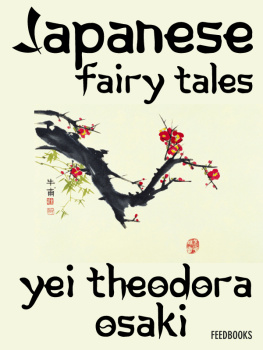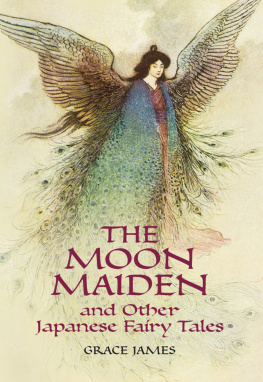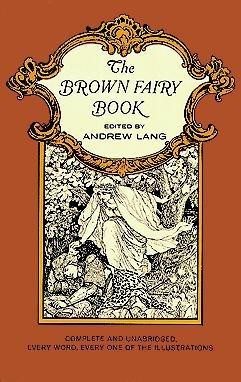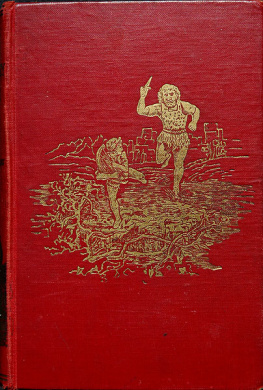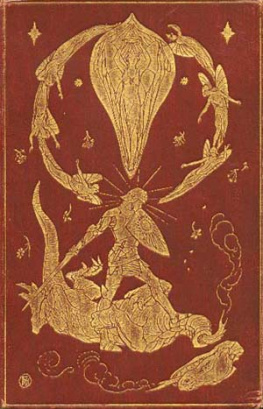I DEDICATE THIS BOOK TO YOU AND TO THE SWEETCHILD-FRIENDSHIP THAT YOU GAVE ME IN THE DAYS SPENT WITH YOU BY THESOUTHERN SEA, WHEN YOU USED TO LISTEN WITH UNFEIGNED PLEASURE TOTHESE FAIRY STORIES FROM FAR JAPAN. MAY THEY NOW REMIND YOU OF MYCHANGELESS LOVE AND REMEMBRANCE.
Y. T. O.
Tokio, 1908.
PREFACE.
This collection of Japanese fairy tales is the outcome of asuggestion made to me indirectly through a friend by Mr. AndrewLang. They have been translated from the modern version written bySadanami Sanjin. These stories are not literal translations, andthough the Japanese story and all quaint Japanese expressions havebeen faithfully preserved, they have been told more with the viewto interest young readers of the West than the technical student offolk-lore.
Grateful acknowledgment is due to Mr. Y. Yasuoka, Miss FusaOkamoto, my brother Nobumori Ozaki, Dr. Yoshihiro Takaki, and MissKameko Yamao, who have helped me with translations.
The story which I have named "The Story of the Man who did notWish to Die" is taken from a little book written a hundred yearsago by one Shinsui Tamenaga. It is named Chosei Furo, or"Longevity." "The Bamboo-cutter and the Moon-child" is taken fromthe classic "Taketari Monogatari," and is NOT classed by theJapanese among their fairy tales, though it really belongs to thisclass of literature.
The pictures were drawn by Mr. Kakuzo Fujiyama, a Tokioartist.
In telling these stories in English I have followed my fancy inadding such touches of local color or description as they seemed toneed or as pleased me, and in one or two instances I have gatheredin an incident from another version. At all times, among myfriends, both young and old, English or American, I have alwaysfound eager listeners to the beautiful legends and fairy tales ofJapan, and in telling them I have also found that they were stillunknown to the vast majority, and this has encouraged me to writethem for the children of the West.
Y. T. O.
Tokio, 1908.
MY LORD BAG OF RICE.
Long, long ago there lived, in Japan a brave warrior known toall as Tawara Toda, or "My Lord Bag of Rice." His true name wasFujiwara Hidesato, and there is a very interesting story of how hecame to change his name.
One day he sallied forth in search of adventures, for he had thenature of a warrior and could not bear to be idle. So he buckled onhis two swords, took his huge bow, much taller than himself, in hishand, and slinging his quiver on his back started out. He had notgone far when he came to the bridge of Seta-no-Karashi spanning oneend of the beautiful Lake Biwa. No sooner had he set foot on thebridge than he saw lying right across his path a hugeserpent-dragon. Its body was so big that it looked like the trunkof a large pine tree and it took up the whole width of the bridge.One of its huge claws rested on the parapet of one side of thebridge, while its tail lay right against the other. The monsterseemed to be asleep, and as it breathed, fire and smoke came out ofits nostrils.
At first Hidesato could not help feeling alarmed at the sight ofthis horrible reptile lying in his path, for he must either turnback or walk right over its body. He was a brave man, however, andputting aside all fear went forward dauntlessly. Crunch, crunch! hestepped now on the dragon's body, now between its coils, andwithout even one glance backward he went on his way.
He had only gone a few steps when he heard some one calling himfrom behind. On turning back he was much surprised to see that themonster dragon had entirely disappeared and in its place was astrange-looking man, who was bowing most ceremoniously to theground. His red hair streamed over his shoulders and was surmountedby a crown in the shape of a dragon's head, and his sea-green dresswas patterned with shells. Hidesato knew at once that this was noordinary mortal and he wondered much at the strange occurrence.Where had the dragon gone in such a short space of time? Or had ittransformed itself into this man, and what did the whole thingmean? While these thoughts passed through his mind he had come upto the man on the bridge and now addressed him:
"Was it you that called me just now?"
"Yes, it was I," answered the man: "I have an earnest request tomake to you. Do you think you can grant it to me?"
"If it is in my power to do so I will," answered Hidesato, "butfirst tell me who you are?"
"I am the Dragon King of the Lake, and my home is in thesewaters just under this bridge."
"And what is it you have to ask of me!" said Hidesato.
"I want you to kill my mortal enemy the centipede, who lives onthe mountain beyond," and the Dragon King pointed to a high peak onthe opposite shore of the lake.
"I have lived now for many years in this lake and I have a largefamily of children and grand-children. For some time past we havelived in terror, for a monster centipede has discovered our home,and night after night it comes and carries off one of my family. Iam powerless to save them. If it goes on much longer like this, notonly shall I lose all my children, but I myself must fall a victimto the monster. I am, therefore, very unhappy, and in my extremityI determined to ask the help of a human being. For many days withthis intention I have waited on the bridge in the shape of thehorrible serpent-dragon that you saw, in the hope that some strongbrave man would come along. But all who came this way, as soon asthey saw me were terrified and ran away as fast as they could. Youare the first man I have found able to look at me without fear, soI knew at once that you were a man of great courage. I beg you tohave pity upon me. Will you not help me and kill my enemy thecentipede?"

